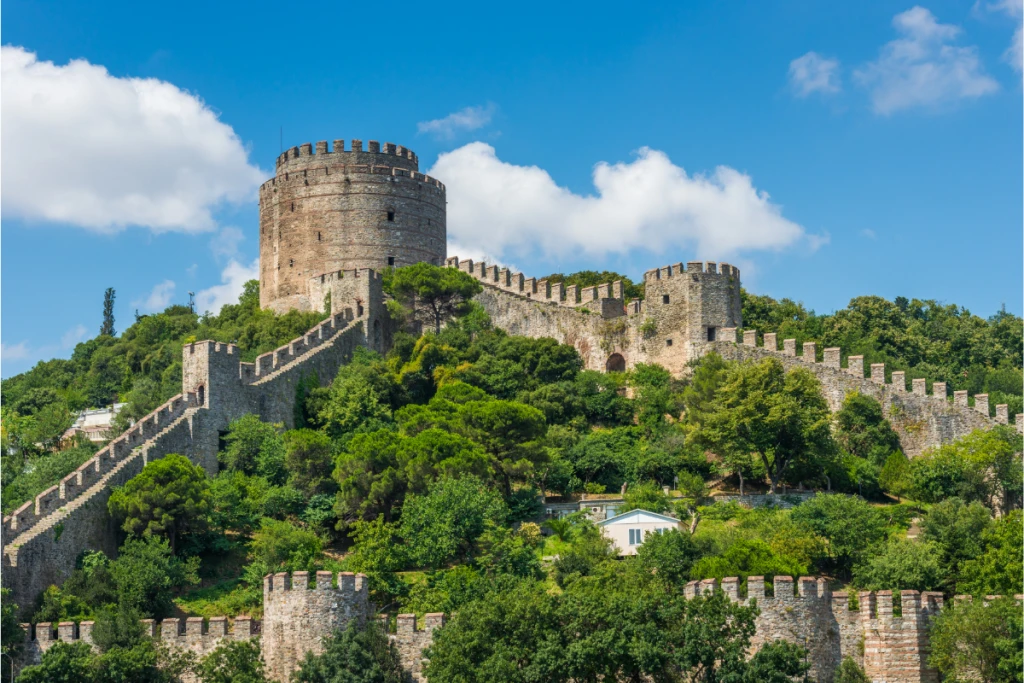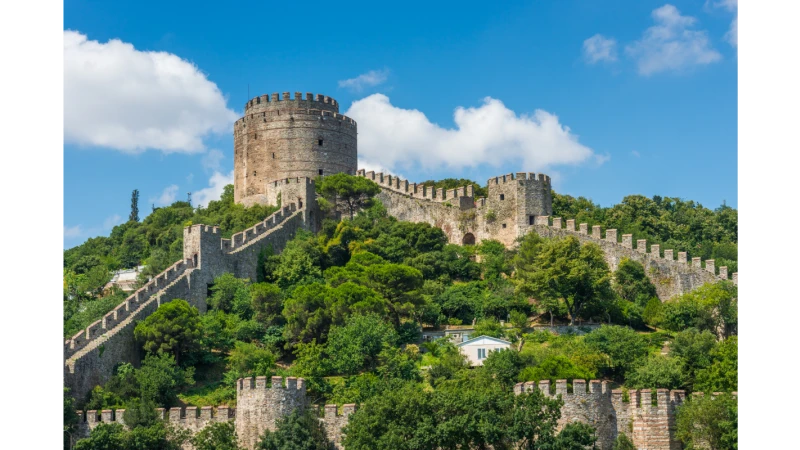Rumeli Hisarı & Anadolu Hisarı – Bosphorus Fortresses Guide

Rumeli Hisarı & Anadolu Hisarı – The Twin Fortresses of the Bosphorus
Introduction
The Bosphorus Strait in Istanbul is not only a natural wonder but also a region of strategic importance throughout history. Guarding this critical waterway are two iconic fortresses: Rumeli Hisarı (Rumeli Fortress) on the European side and Anadolu Hisarı (Anatolian Fortress) on the Asian side.
These “twin fortresses” were built by the Ottomans in the 14th and 15th centuries to control passage through the Bosphorus. Today, they stand as monumental witnesses to Istanbul’s past, offering visitors history, architecture, and breathtaking views of the Bosphorus.
📍 Related Read: Bosphorus Cruise – Day, Sunset & Dinner Tours
History of Rumeli Hisarı
Construction by Sultan Mehmed II
Rumeli Hisarı, also known as Boğazkesen Fortress, was commissioned in 1452 by Sultan Mehmed II (Mehmed the Conqueror), just one year before the conquest of Constantinople. Its purpose was clear: to cut off Byzantine aid from the Black Sea and prepare for the final siege.
Role in the Conquest of Constantinople
The fortress was completed in just four months—a remarkable feat. With its cannons positioned toward the sea, Rumeli Hisarı controlled maritime traffic, preventing supplies from reaching the Byzantine capital.
Later Use
After the conquest in 1453, Rumeli Hisarı lost its military role and was used as a customs checkpoint and later as a prison. Today, it is a popular museum and open-air venue for cultural events.
🔗 External Source: UNESCO – Historic Areas of Istanbul
History of Anadolu Hisarı
Construction by Sultan Bayezid I
On the Asian shore, Anadolu Hisarı was built earlier in 1394 by Sultan Bayezid I (Yıldırım Bayezid). It was the first Ottoman fortress in Istanbul, constructed to strengthen Ottoman control over the Bosphorus.
Strategic Importance
Although smaller than Rumeli Hisarı, Anadolu Hisarı played a key role in securing the strait and monitoring Byzantine activity. When Rumeli Hisarı was completed, the two fortresses together effectively “locked” the Bosphorus, ensuring Ottoman dominance.
Later Use
Over time, Anadolu Hisarı became less significant militarily and was surrounded by the charming neighborhood of Anadoluhisarı, known for its traditional wooden houses.
Architecture of the Fortresses
Rumeli Hisarı
- Covers 30,000 square meters
- Features three large towers named after Mehmed’s viziers (Halil, Zağanos, Sarıca Pasha)
- Surrounded by massive stone walls stretching 250 meters along the Bosphorus
- Positioned on the narrowest part of the Bosphorus (only 660 meters wide)
Anadolu Hisarı
- Much smaller (approx. 7,000 square meters)
- Central keep tower surrounded by walls and smaller bastions
- Built on a promontory at the confluence of the Göksu River and the Bosphorus
📍 Related Read: Topkapı Palace – The Imperial Heart of Istanbul
Visiting Rumeli & Anadolu Hisarı
📍 Location
- Rumeli Hisarı: European side, Sarıyer district, near the Fatih Sultan Mehmet Bridge
- Anadolu Hisarı: Asian side, Beykoz district, at the Göksu River
🕒 Opening Hours
- Rumeli Hisarı: Open daily (except Mondays) 09:00 – 19:00
- Anadolu Hisarı: Currently closed for restoration, but its exterior can be viewed
🎟️ Tickets
- Rumeli Hisarı Museum: ~200 TL (approx. €6)
- Anadolu Hisarı: Exterior viewing only (free)
🔗 External Source: GoTürkiye – Official Tourism Site
🚍 How to Get There
- By Ferry: Many Bosphorus Cruises pass both fortresses
- By Bus: From Beşiktaş or Kabataş to Sarıyer (for Rumeli Hisarı)
- By Car: Both fortresses are near the Bosphorus bridges
📍 Related Read: Basilica Cistern – Underground Wonder of Istanbul
Things to Do at Rumeli & Anadolu Hisarı
- Explore the Fortress Walls: Walk through Rumeli Hisarı’s towers and courtyards for panoramic Bosphorus views
- Visit the Museum: Learn about Ottoman military history at Rumeli Hisarı Museum
- Enjoy Local Cafés: Sit in waterfront tea gardens with fortress backdrops
- Take a Bosphorus Cruise: See the fortresses from the water for the best perspective
- Photography: Capture Istanbul’s unique blend of medieval architecture and modern bridges
Cultural Significance
- Rumeli Hisarı is a symbol of Ottoman determination and military strategy before the conquest of Constantinople.
- Anadolu Hisarı reflects the early expansion of the Ottomans into the Bosphorus region.
- Together, they represent the East-West balance of Istanbul, guarding the Bosphorus like two watchful sentinels.
📍 Related Tour: 6-Day Western Turkey Tour – Istanbul, Gallipoli, Ephesus & Pamukkale
SEO Optimized FAQ – Rumeli & Anadolu Hisarı
1. Why were Rumeli Hisarı and Anadolu Hisarı built?
To control the Bosphorus and prepare for the Ottoman conquest of Constantinople.
2. Who built Rumeli Hisarı?
Commissioned by Sultan Mehmed II in 1452.
3. Who built Anadolu Hisarı?
Constructed by Sultan Bayezid I in 1394.
4. Where are the fortresses located?
Rumeli Hisarı is on the European side; Anadolu Hisarı is on the Asian side.
5. Can visitors enter Rumeli Hisarı?
Yes, it is a museum open to the public.
6. Is Anadolu Hisarı open to visitors?
It is closed for restoration but can be viewed from the outside.
7. What is the best way to see both fortresses?
By taking a Bosphorus Cruise.
8. Are Rumeli & Anadolu Hisarı UNESCO sites?
They are part of the Historic Areas of Istanbul, a UNESCO World Heritage Site.
9. How long does it take to visit Rumeli Hisarı?
About 1–2 hours.
10. Which tours include the fortresses?
Most Bosphorus tours and cruises pass by both fortresses.
Conclusion
The Rumeli and Anadolu Fortresses are more than just stone walls—they are symbols of Istanbul’s history, representing the Ottoman rise and the conquest that changed world history.
Visiting these fortresses, whether from land or on a Bosphorus Cruise, allows travelers to connect with Istanbul’s strategic importance and breathtaking beauty.
No trip to Istanbul is complete without witnessing the twin guardians of the Bosphorus.
📍 Related Experience: Cappadocia Private Mix Tour – Red & Green Highlights













